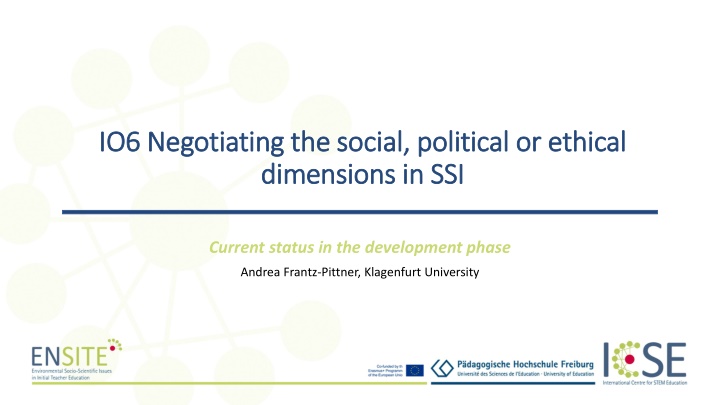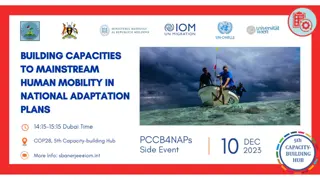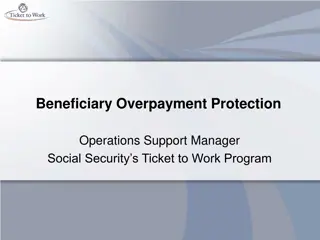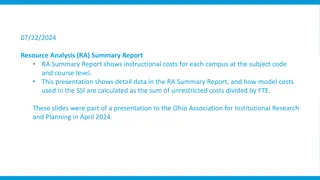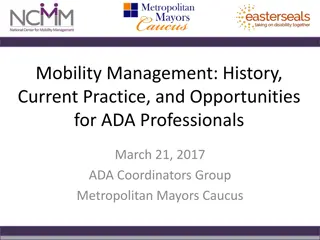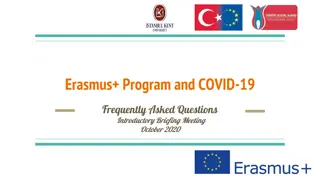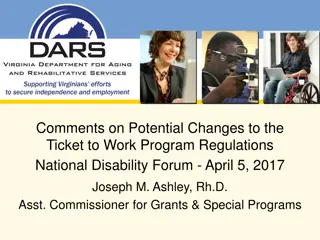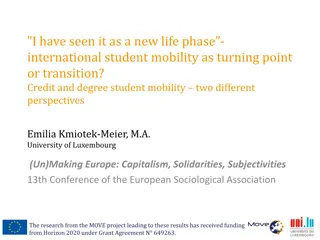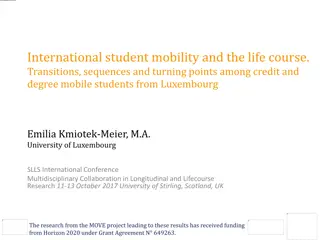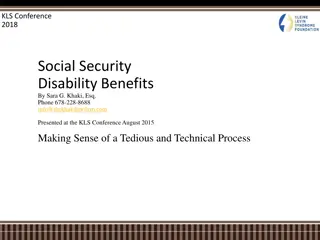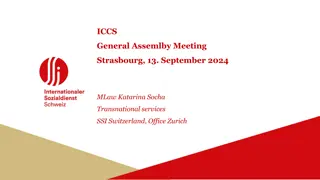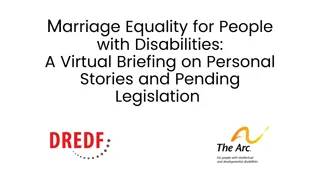Dimensions of SSI Mobility
In this module, future teachers in initial education explore the social, political, ethical, and ecological perspectives of mobility as a Socio-Scientific Issue (SSI). They analyze teaching elements, develop exercises, and lesson plans to integrate mobility issues into curriculum content and sustainability goals. Through immersive and subject-related methods, teacher trainees learn to connect mobility topics to education goals. Guided by guidelines focusing on active student learning, they engage in role-plays, creative elements, and reflective practices to understand the complexities of mobility decisions.
Uploaded on Mar 14, 2025 | 1 Views
Download Presentation

Please find below an Image/Link to download the presentation.
The content on the website is provided AS IS for your information and personal use only. It may not be sold, licensed, or shared on other websites without obtaining consent from the author.If you encounter any issues during the download, it is possible that the publisher has removed the file from their server.
You are allowed to download the files provided on this website for personal or commercial use, subject to the condition that they are used lawfully. All files are the property of their respective owners.
The content on the website is provided AS IS for your information and personal use only. It may not be sold, licensed, or shared on other websites without obtaining consent from the author.
E N D
Presentation Transcript
IO6 Negotiating the social, political or ethical IO6 Negotiating the social, political or ethical dimensions in SSI dimensions in SSI Current status in the development phase Andrea Frantz-Pittner, Klagenfurt University
General overview and aim General overview and aim In this module future teachers in initial teacher education are exploring the topic of mobility and learning about its potential as an SSI. Based on their own experiences, they identify social, political, ethical and ecological perspectives of mobility. The teacher trainees establish links between mobility issues and curriculum content, sustainability goals and citizenship competences. They analyze SSI teaching elements on the topic of mobility and then develop their own exercises and lesson plans The intention is to raise the future teachers' awareness about the controversies and heterogenous data out of different research disciplines in this issue. They reflect about which different perspectives must converge in this problem area relevant to everyday life in order to develop socially sustainable solutions. They should discover that there are meaningful circumstances in the direct everyday environment of the students that can be used for SSI teaching. They learn how to take up mobility-related current issues from the local context of the children and to design SSI learning activities based on this.
Flowchart and Module plan Flowchart and Module plan Dimensions of the SSI Mobility How to connect mobility SSIs to different goals of education? Implementation of mobility related SSIs in classroom Activity 1.1 Municipality council Activitiy 1.2: My mobility pattern ; Activity 1.3: Collecting mobility data Activity 1.4. Local mobility situation Activity 2.1: Identify aspects in mobility issues related to mathematics and science education Activity 2.2: Mobility related sustainability and citizenship education Activity 2.3: Locally discussed mobility issues Activity 3.1: Analysis of mobility related SSI lessons? Activity 3.2: Development of SSI lessons based on local mobility issues
Guidelines for Methods Guidelines for Methods Immersive: Emotionally, by linking up with personal experiences, taking on different roles and perspectives Subject-related, through broad immersion in methods and findings of interdisciplinary multi- perspective mobility research Prioritizing students active learning: As little direct input from the teacher educators as possible Discursive Formats Own experience Creative elements Reflective practices
1. Dimensions of Mobility Activity 1.1 Municipality Council Duration: 45 This is a warm up activity. The intention is to outline the diverse perspectives of mobility decisions and to create awareness of the complexity of evidence-based decision making. In a role-play, the pre-service teachers slip into the roles of members of a municipality council in small groups, which debates traffic planning in the town. Depending on the department (e.g. health officer, environmental officer, financial officer, economic officer, social officer...) the topic is viewed from a different perspective and on the basis of different background material. Each officer suggests a mobility related measure for the municipality and the council debates about these suggestions. The municipal council draws up a list of measures on which there is agreement, which lead to controversy and which data are still needed for a decision Teacher Educators introduce the module using the ppt presentation [1] and then present the activity 1.1 to preservice teachers.
1. Dimensions of Mobility Activity 1.2: My Mobility Pattern Duration: 30 Students in teacher training create concept maps of their personal routes and goals and the means of transport chosen for them. In small groups they compare their diagrams and explain their mobility decisions. Together they create an overview of the pros and cons for each means of transport and calculate the modal split of the group.
1. Dimensions of Mobility Activity 1.3: Collecting and evaluating mobility informations Duration: 60 In an info-quest, the pre-service teachers collect a wide range of information on traffic topics (e.g. newspapers, research reports, statements of politicians, ...). In small groups they evaluate these documents according to their credibility , relevance , the perspective of the author and prepare a statement on the topic. (Topics are e.g. e-mobility, landuse, air pollution, public transport, safety in traffic, road pricing, ) Using the "world cafe" method, student teachers reflect on their own attitudes and beliefs regarding social, political and ethical dimensions in relation to mobility. They discuss what information and experiences underlie their own attitudes, what sources of information they use and what influences might lead them to change their mind.
1. Dimensions of Mobility Activity 1.4. Local mobility situation Duration: 60 On the basis of a questionnaire, the student teachers collect various parameters of the mobility situation at their place of residence. Both internet research (e.g. air quality, public transport services, accident figures, ...) and own surveys (e.g. noise measurements with an app) are used. They collect ideas for problems that have the potential to be controversially discussed.
2. How to connect mobility SSIs to different goals of education? Activity 2.1: Identify aspects in mobility issues related to mathematics and science education Duration: 30 Based on the topics collected in the homework exercise, the student teachers consider what data and information would be necessary for a factual discourse in this matter. They compare this collection with the curriculum content and identify links between curriculum and mobility related SSIs
2. How to connect mobility SSIs to different goals of education? Activity 2.2: Mobility related sustainability and citizenship education Duration: 45 The students are introduced to the United Nations Sustainable Development Goals with a presentation by the teacher educator. In groups of two they work on possible relationships between mobility and the respective sustainability goal. The results of the different working groups will be combined into a concept map about mobility and its implications on society. In the plenary session, the student teachers discuss what responsible citizenship could mean in this field of social action and what skills and knowledge are required.
2. How to connect mobility SSIs to different goals of education? Activity 2.3: Locally discussed mobility issues Duration: 45 Students search local newspapers for reports on mobility-related problems. They select a problem and write two letters to the editor from different positions (e.g. gas station owner and parent representative of the kindergarten)
Implementation of mobility related SSIs in classroom Activity 3.1: Analysis of mobility related SSI lessons Duration: 30 The students receive lesson plans and working materials from the "Keep Moving" project. In small groups they analyse the materials on the basis of the data used, the perspectives represented and the references to the curriculum.
Implementation of mobility related SSIs in classroom 3.2: Development of SSI lessons based on local mobility issues Duration: 135 In groups of two, the student teachers choose one of the proposed problems each. Using a planning scheme, they develop a teaching concept. First of all, they search for suitable data material. Then they select learning objectives and develop teaching activities using creative techniques. Each group then tests the lesson setting of the other group and provides feedback. Using the "case and box" method the final reflection of the module takes place.
Lets talk about. What do you think about the concept? Are there overlaps with other IOs? In which activities do we have to coordinate with each other?
Im l looking forward to work with you in an exciting project! Andrea.Frantz@aau.at
